This smattering of zine reviews appeared on the Reglar Wiglar website or blog in the aughts and teens of the 21st Century. Enjoy them, won’t you?
To read zine reviews from the print version, go here.
13 Years of Good Luck
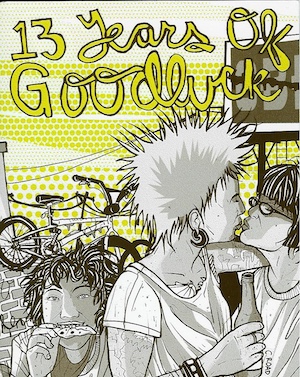
Joel Biel
In 2009, Microcosm celebrated thirteen years of existence as an indie distributor and publisher. Thirteen Years of Good Luck is a greatest-hits package of writers and artists whose work has been published by the collective.
This 96-pager bursts with first-time reprints, in most cases (Jesse Reklaw, Cindy Crabb, Urban Hermitt, and founder Joel Biel) and never-before-published stuff in others (Liz Baillie, Cristy Road, Al Burian). Some of the type is pretty tiny for my tired eyes but the overall package looks great and serves as an overview of what has become—I think it’s fair to say—a DIY institution. You can’t beat the price either: one buck!
While this zine highlights the heavy-handedness of the police department’s overreaction, there’s the implication (which is more than implied but alleged in the accompanying press sheet) that Portland Critical Mass was “brutally torn down” by the PPD. This would seem to suggest that the Portland Police Department is something akin to the KGB or the Stasi or their contemporaries in modern-day dictatorships. Maybe this is a result of what’s going on in the world in 2011, but I personally was not persuaded that the police actions rose to the level of brutality. I’m sure Libyans would love these sorts of problems, but I don’t live in Libya and I don’t live in Portland and I’ve got my own CPD to watch out for.
It should be mentioned that some of the documents featured in this zine are presented in Mad Lib form in an effort to get people to start reading by having a little fun with the subject, but overall I found that less interesting than the actual memos themselves. [www.joebiel.com]
Alive with Vigor
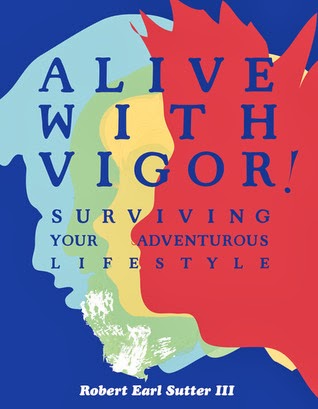
Compiled by Rob Sutter III [Microcosm Publishing]
Alive with Vigor is like a compilation of advice columns that dispense nuggets of wisdom on a range of topics from medical issues to dating and personal finance. That’s pretty much half the internet right there, but the internet won’t give you all this valuable information in the form of a really cool-looking zine, will it? No, it won’t.
Although the purpose of this book is to help people survive an “adventurous lifestyle,” there isn’t a whole lot in here that isn’t universal: constipation, diarrhea, autoimmune disorders, breast cancer, and abusive relationships can affect anyone regardless of their lifestyle, but the intended audience is those people that are, perhaps, on the fringe of society: the punkers, the transgendered, the outcasts (both willing and unwilling), the renegades, the rebels, etc. This book is for them.
Contributors to Alive with Vigor include Joe Biel, Buck Angel, Ayun Halliday, Rob Sutter III (who put this guide together), and a host of other folks who are into the DIY spirit and living an alternative lifestyle.
Beyond the Music
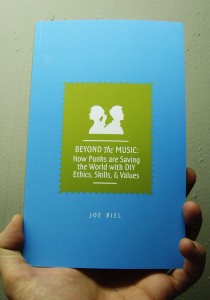
Joe Biel [Microcosm Publishing]
Subtitled, “How Punks are Saving the World with DIY Ethics, Skills & Values,” Beyond the Music collects interviews with dozens of movers and shakers in the punk scene—and not the safety-pinned, mohawked, vomity punk bands of legend either. No, we’re talking about the printers, publishers, artists, writers, and organizers—real, everyday folks who are out there trying to create, produce, and contribute to the world using their own set of ethics, guidelines, and principles.
Collected between 2008 and 2012, with some pieces previously published elsewhere, editor Joe Biel focuses on the individuals in the punk community who have made a lasting commitment and contribution to promoting the aforementioned “DIY ethics, skills and values”.
Such luminaries as Todd Taylor of Razorcake, Ian Mackaye of Dischord Records, Chris Clavin of Plan It X Records, zinesters Urban Hermitt, Al Burian, and Robnoxious, and a whole smattering of punks from vegan chefs (Joshua Ploeg) to polarizing pundits (Ben Weasel) are given a forum to relate their stories and philosophies. Some may be unfamiliar to you, and some may be household names in your house, but there’s something to glean from all of them be it inspirational and/ or informational.
Big Diamond
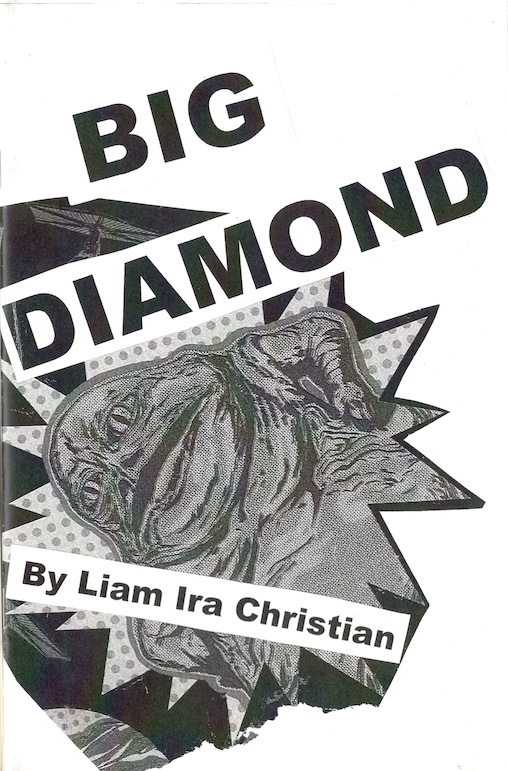
Liam Ira Christian [Pioneers Press]
If I had read the “About the Artist” page at the end of this zine first, that would have cleared up a lot of things for me early on. However, I did not see it until I had finished reading this short zine. That said, I was trying hard not to be too judgmental of this publication and its creator as I turned the pages, but I was beginning to think Liam Christian was a bit overzealous in what I could only describe as an attempt at outsider art. Discovering that Liam is in fact a three-year-old who took the photos, wrote the captions, and chose the accompanying artwork for the zine himself, came as some relief. I started over from the beginning with this newfound knowledge and suddenly it all made sense. Well, it made more sense at any rate.
Big Diamond is Liam’s first zine. It is a collection of photos and cutout images he found interesting. Star Wars is a theme that is explored here. He is the son of Jesse Duke, the proprietor of Pioneers Press and the Hard Fifty Farm in NE Kansas. That would mean Liam has been surrounded by zines his entire life and there will surely be more of his own publications to come. No matter what age your are, from three to 83, everything you create is valid and worthy of publishing and sharing in my opinion, so save your stuff, save your kid’s stuff. My mom did and look what happened to it all these decades later.
Bipedal, By Pedal! #2
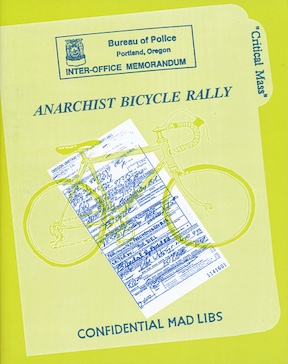
Joe Biel [Cantankerous Titles]
Thanks to the Freedom of Information Act, zinemaker, Joe Biel, was able to obtain Portland Police documents detailing that department’s efforts to monitor and contain (and eventually help end) Portland’s Critical Mass movement. While some of the documents are merely bureaucratic interoffice memos, it’s an interesting glimpse into the inner workings of the police. The charge leveled at the cops in this instance is that of spying—the department used undercover officers to infiltrate rally planning meetings to gather information on these supposed “Anarchist” cyclists. While that certainly seems like overkill, it is apparently entirely legal.
The Bobby Joe Ebola Songbook
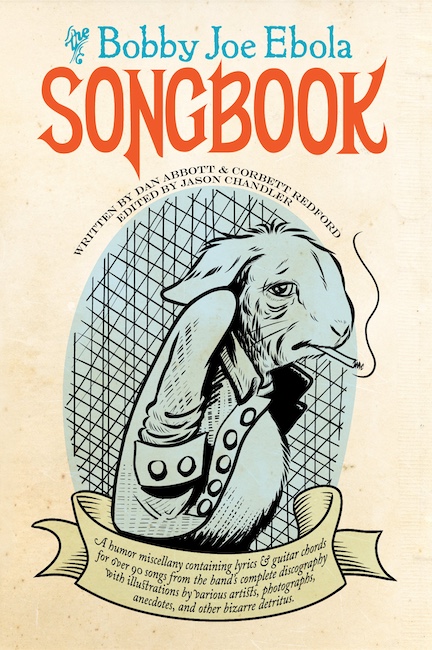
Dan Abbott & Corbett Redford, Edited by Jason Chandler [Microcosm Publishing]
Those living in the Bay Area may be familiar with the various antics, shenanigans, and miscellaneous malarky instigated by the duo of Dan Abbott & Corbett Redford. In the guise of their alter ego band, Bobby Joe Ebola & The Children MacNuggits, this folk punk comedy band has been entertaining grown-up kids for over 15 years.
The Bobby Joe Ebola Songbook is a big fat collection of over 80 BJE tunes. While the book comes complete with chords and lyrics, it’s not necessarily intended for the serious musician. It serves more as a memento for fans to remember the band and also features trivia, pop quizzes, band pin-ups and assorted tips and treats. The book has been lovingly illustrated by a host of artists including Winston Smith, Mitch Clem, Cristy Road, Andy Warner, Keeli McCarthy, Petr Sorfa, and many others. This is a great accompaniment to the actual BJE recordings for newbies and old fans alike. [ bobbyjoeebola.com]
The Book Bindery

Sarah Royal [Microcosm Publishing]
This small bound book is about book bindery. It’s a collection of the zine of the same name and documents Sarah Royal’s time in Chicago working at a West Side book bindery. Not the romantic environs one might picture of artisans lovingly assembling classics of literature, or producing the cutting edge in experimental fiction, but rather the binding of mind-numbing law publications. However, the characters and everyday situations Sarah encounters during her seemingly menial occupation provide the grist for some compelling tales of deranged bosses, delusional co-workers, and destitute hood rats. Sarah also befriends a few commuters on the 55 bus which makes for additional character studies. Every workplace is a microcosm populated with odd players and the book bindery is certainly no exception.
Burn Collector #14
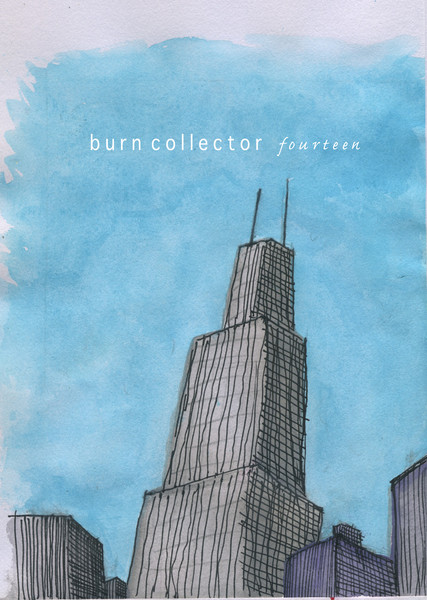
Al Burian [Microcosm Publishing]
Burn Collector #14 is a pocket-sized zine containing the further adventures of writer/artist and musician Al Burian. Al spent a few years in Chicago wandering the city, playing in bands, writing, drawing and just trying to survive on the fringe.
This issue has Burian confronting such day-to-day struggles as dealing with the Chicago Transit Authority—talk about a character builder. There are ruminations on cycling in a bike-hostile city and the appeal of street musicians and house shows over concerts in more traditional venues (bars, clubs, etc.). There’s also a treatise of sorts in the form of a rebuttal to “The Future of Comics”, a 1997 article by artist Dan Clowes that appeared in his Eightball #8 comic.
Comics are a theme in BC#14, in fact. Burian’s drawings appear throughout the issue. There are assorted sketches and one-panel strips as well as a parody of a Jack Chick religious tract that just gets flat-out weird by the end. A good read for riding the CTA, which is about to get a whole lot suckier with their new service cuts this February. Fuckin’ CTA.
Burn Collector #15

Al Burian [Microcosm Publishing]
Al Burian is back for another issue of Burn Collector. BC #15 finds Al living in Berlin. Like always, Al shares his thoughts and observations on life in his newly chosen city, but before that he needs to deal with a searing toothache that sends him immediately to the streets in search of a dentist. After an aborted first attempt at the dental office in the building he lives in, Al finds a caring, gentle soul who is willing to ease his pain. She of course disproves of Al’s lack of preventive dental maintenance. Al returns later to plead poverty to the woman, who he hopes will fall in love with him and forgive his debt to her. Doesn’t happen.
Also in this issue, Anne Elizabeth Moore contributes a piece, “When You Realize the Freedom” (title courtesy of a Hasselhoff lyric) on the selling of the Berlin Wall (more literally than figuratively). There’s an interview with fellow zine-maker and ex-pat Liam Warfield on living in Berlin. Al also reviews various things like Berlin’s Tegel Airport, books on writing (Ernest Hemingway, Stephen King), people (Ronnie James Dio) as well as various records, squats, and Germany’s May 1st holiday.
Always good to check in. No comics though? What’s up with that, Al?[alburian.com]
Chainbreaker Bike Book: A Rough Guide to Bicycle Maintenance
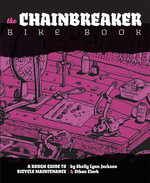
Shelly Lynn Jackson & Ethan Clark [Microcosm Publishing]
Half handy guide to bicycle maintenance, half zine about all things bike, The Chainbreaker Bike Book is a comprehensive, illustrated manual for maintaining your ride. The book covers everything from dealing with your bike (from tools to tune-ups) to dealing with bike shops. Authors Ethan and Shelly both have long histories with bicycles and have both worked at the Plan B bike collective in New Orleans, so they not only have a passion for the material, they have the knowledge to back it up. The guide is intended for anyone and everyone who has an interest in self-propelled, self-sustained, two-wheeled transport regardless of the make or model of the bike or its rider. The back half of the book is the first four issues of the Chainbreaker zine that celebrated bike culture, and New Orleans specifically, which is a huge bonus to an already valuable publication. Ride your bike!
The CIA Makes Science Fiction Unexciting #6: The Life of Lee Harvey Oswald
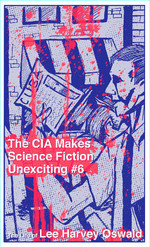
Abner Smith [Microcosm Publishing]
Two thousand and eleven marks the 10th anniversary of Microcosm’s CIAMSFU series. This is the first one I’ve read, so I’m only a decade behind at this point. Issue number six is a short bio of Kennedy assassin, Lee Harvey Oswald. Using declassified government documents, writer Abner Smith constructs Oswald’s life from his troubled childhood in New Orleans through his troubled military career to his troubled time in the Soviet Union (and his unsuccessful attempts at defection) and his troubled marriage to a young Russian woman.
Seems like Oswald was a bit troubled—a loose nut, probably not to be trusted as a spy or double agent. He was more likely than not, just a disillusioned wanna-be revolutionary and hardly someone the government would want to work with in the assassination plot of one of the most powerful men in the world. Yet something doesn’t quite fit and this is the CIA we’re talking about here. If you lean even slightly toward conspiracy theories regarding this pivotal part of American History, the ultimate objective was achieved and we know Oswald didn’t spill his guts. Well…
An interesting read for sure, but Smith doesn’t necessarily shed a lot of light on the subject for me. His writing style is a little clipped and he could have probably benefited from an editor to help organize his thoughts a little better, but this is a zine, not a graduate thesis so that’s a gripe, not a dis. It is amazing the things the CIA/FBI and the US Government think they can get away with. What would probably be even more amazing, are the things they have gotten away with that we’ll never know about.
Cometbus #54
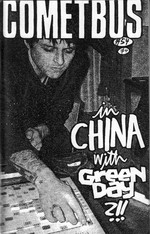
Haven’t read Cometbus in a while. I like the switch to type even though Aaron does have very legible handwriting. It’s just much easier on these old eyeballs. This issue sees Aaron on tour with longtime pals Green Day.
It seems that his relationship with one of the biggest bands in the world has come full circle from the Berkeley days of the early 90s. This gives Aarron pause for thought as he contemplates the way his relationship with the band has evolved. There’s some self-reflection on the views of Aaron’s younger self, which may have been a tad rigid in retrospect. He also remembers that Green Day—a band that was decried as sellouts to the Berkeley punk scene—was never accepted by that scene in the first place.
At the end of the day, and at the end of his brief stint on the tour, Aaron has a newfound respect for his old friends. These are all revelations Aaron has as he wanders city streets in Thailand, Japan and Singapore. I was never a big Green Day fan myself, but the longevity of their career forces me to give them props, especially considering all the cookie-cutter pop-punk bands they left in their wake. Aaron exposes Green Day for who they really are: regular people that other regular people put up on pedestals.
Devastator #4
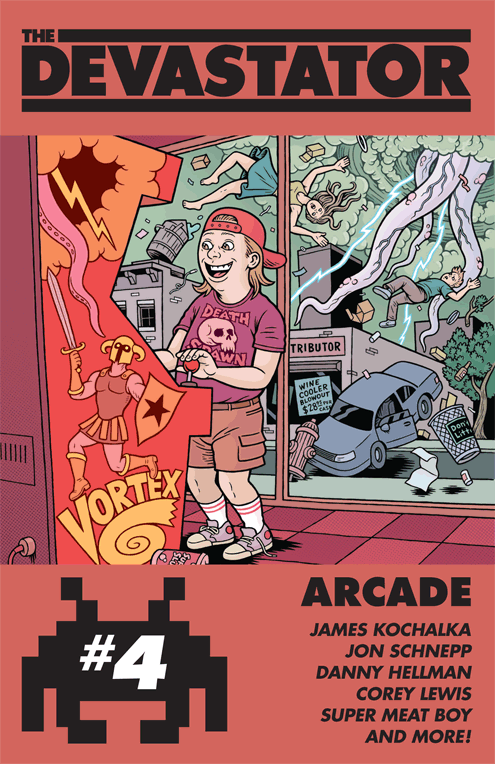
Various [Devastator]
Devastator is a comedy magazine in digest form. It contains comics and other writings of a satirical nature intended to make you laugh, preferably out loud. It succeeds in this endeavor. Number four is the “Arcade” issue, although nostalgia is really the theme here. This is immediately evident from the flip side of the book, which is a parody of my beloved Choose Your Own Adventure series from the 70s and 80s. Writer John Ford skewers the genre with “Night at the Arrrrr-cade!” where the second person you get trapped in a haunted game room. They’ve got everything down to a tee in terms of the fonts and writing style of those books and Marc J. Palm’s cover is spot-on in its imitation.
There are comics too, with James Kochalka delivering a Glorkian Warrior’s tale in “Attract Mode,” Matt Taylor’s “Marriage Command” is good for a giggle and Edmund McMillen serves up something called “Meat Boy and Dr. Fetus” in the tradition of Goofus and Gallant.
Some of the satirical targets of Devastator are either before or after my time (probably after, sadly) like Amanda Meadows’ “Mr. Do: Return of the Dino Drones” which parodies Scholastic Publishing’s Blast into Books series, of which I am unfamiliar. Judging from this piece, however, I get the gist of what those books are like. I know the type of crap education publishers try to download to developing brains.
Even the revered Atari 2600 is not spared the comedic wrath of Devastator. John Schnepp delivers a withering indictment of Atari’s 1979 game “Adventure” titled “Sadventure”. And deservedly so, I mean, did they really expect us to believe that floating duck was a frickin’ dragon? That game sucked on so many levels (pun intended).
And there’s plenty more in this issue that a brief recap, such as this, is forced to omit. In short, Devastator showcases a mountain of talent by writers and artists who also contribute to some big names in comedy from Conan to the Onion News Network. And it looks great too.
The DIY Guide to Fighting the Big Motherfucking Sad
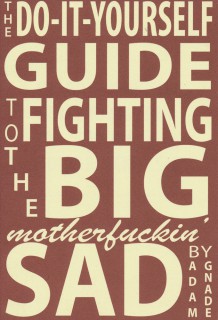
Adam Gnade [Pioneers Press]
Writer Adam Gnade offers us a guide for how he deals with what he calls “The Big Motherfucking Sad” aka depression.
As soon as I opened up Adam’s fight guide, I instantly recognized something in myself. In the book’s introduction, Adam tells us that he dreams of dissecting his life—giving us a list of how tired or sick he felt on a certain day, what foods he ate, and how he felt when he got up in the morning—all in an effort to detect the patterns of his life. Three years ago, I started to keep a journal for these very same reasons. I was inspired at the time by Jesse Reklaw’s daily comics journal, Ten Thousand Things to Do. I kept a daily record of what I ate, drank, the basics of what went down that particular day, and what my mood was (good, bad, pissed, bummed). I wanted to see if I could recognize patterns. Was I depressed because I drank too much that particular week or did I drink because I was depressed? Did slipping into a lazy junk food diet cause my depression or did I turn to these comfort foods as a result of it? I am not someone who suffers from clinical depression, but I get bummed out like everyone else and if being in mental pain is comparable to being in physical pain, then it’s important to know the cause of the affliction so that it can be corrected.
Gnade doesn’t deal with the root causes of the “Big Motherfucking Sad,” recognizing that they vary by individual, but he does offer tips for school depression’s ass. He puts forth suggestions (commands, really) on how to not let the buggers get you down. There’s a “Guide to Not Freaking Out All the Time,” advice on how to deal with the critics and the haters and other assorted maxims you can use to pump yourself up when you’re feeling deflated. That’s the purpose of this book, which undoubtedly provided the same comfort to its author.
This zine is not a cure-all for anything, it’s just a tool you can use to help you continue to kick ass on a daily basis. A few months ago I stopped keeping my daily journal. Not out of laziness, but after three years I became pretty adept at recognizing the patterns I had been recording. When you know what’s coming you can prepare yourself for it. So, if you suffer from chronic depression, seasonal depression, or stress-related sadness, you would do well to have this pocket-sized pep talk close by. Don’t let it creep up on you and don’t let the bastards get you down. [adamgnade.com]
Doris #15: Anti-Depression Guide
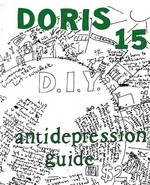
Cindy Crabb [Microcosm Publishing]
This is a reprint of Cindy Crabb’s Doris #15 which serves, it is hoped, as an anti-depression guide. Cindy recommends long walks, daydreaming, remaining active and productive, and drinking lots and lots of coffee. I’m sure scientific evidence would back all these claims up, except perhaps the abuse of caffeine. This zine was originally written in “1999 or 2000” according to Cindy’s best recollection. Certainly then, as now, chemical remedies were a very popular form of curing depression. Certainly, exercise and reconnecting with the outside world can be just as effective, especially for people for whom depression is more environmentally related than a result of chemical imbalances in the brain. But hey, I’m not a doctor, a shrink, a life coach, an Oprah, or even your best friend, so don’t take my word for it. Do consider reading this zine, however, it could only help you shake those blues.
Dream Whip #1-10
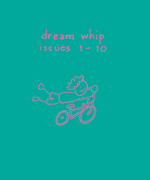
Bill Brown [Microcosm Publishing]
Dream Whip is an unabridged compilation of Bill Brown’s long-running zine of the same name. Seems like Bill did a lot of traveling between 1994 and 1999 and his zine chronicles that time on the road. DW is filled with short pieces, both fictional and nonfictional observations, comics, drawings, and tidbits cut out of local newspapers and tourist brochures. The writing style can come off sounding like that of a freshman writing student at times. It suffers from simile overload in places and it seeks to flatter Beat writers in its imitation, but that’s likely a result of a young writer trying to find a voice of his own. There’s much improvement by issue number ten which Bill instructs readers to treat as a road map of his travels from Texas to Canada and back again.
Dwelling Portably
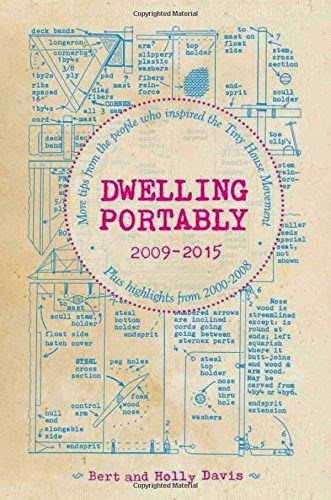
Bert & Holly Davis [Microcosm Publishing]
Dwelling Portably has been around awhile—dang nearly forty years, in fact. I remember receiving issues in my P.O. box back in the ’90s. Even then this zine was crammed to the margins with advice about existing off the grid and living off the land. I loved the idea of Dwelling Portably and the chaotic look and feel of it, but the information contained within never held much relevance to me as an urban dweller. It’s nice to see it compiled here, although the type is just as tiny and condensed as ever. DP is still jam-packed to bursting with how-to’s, advice, and DIY guides for the nomadic life and is still dutifully put together by Bert and Holly Davis, who have been dwelling portably in Somewhereville, Oregon for well past thirty years.
Dwelling Portably #5

Bert & Holly Davis [Microcosm Publishing]
Dwelling Portably is a bit of a turducken of sorts: it’s a zine, stuffed within a zine, stuffed within a zine with reprints of other, similar publications reprinted within its pages. That makes for a jam-packed, endlessly informative guide for people who choose to live on the fringes of society. It also makes for some fascinating reading for city folks like myself who enjoy the escapism of thinking about this type of nomadic lifestyle. The text starts about an inch down from the top of the front cover and doesn’t stop until about an inch up from the bottom of the back cover. In between you’ll find foraging techniques, tips on gardening, shelter building, the best natural remedies, the best camping sites, and all manner of information on how to live sustainably and completely off the grid.
East Village Inky #48

Ayun Halliday [ayunhalliday.com]
One-time member of the Chicago Neo-Futurists theatre company, Northwestern grad, writer of several books, zinester, and native Hoosier, Ayun Halliday is now the proud publisher of forty-eight issues of The East Village Inky.
EVI began when Ayun and her husband Greg Kotis (Urinetown, look it up!) lived in an East Village apartment. Now in Brooklyn with two children, she continues to produce this hand-drawn, handwritten, and hand-laid-out zine. This is my first encounter with EVI and just my luck, it’s also the first ever music issue, and I like music.
In this forty-page mini, Ayun recounts tales of her musical listening history touching upon early influences from grade school through high school, college, and beyond. I must admit, I do not have much in common with Ayun as far as musical tastes (Todd Rundgren is the zine’s centerfold for example), but I won’t dwell on that. What I can relate to is the joy of making and receiving mixtapes and I agree that movie soundtracks are good ways to discover new music that is often old music.
I enjoyed the section in which a smattering of “hip” Brooklyn teens are interviewed about what they’re listening to. They seem to have pretty developed musical tastes, which is either due to living in Brooklyn, their parents, the accessibility of music on the Internet or all three—the perfect storm for “hip” in this modern age, I suppose.
EVI reads like a conversation you’re having with a friend you haven’t seen in a while and you only have a short time to talk. A lot gets crammed in, topics change quickly and sometimes you lose the thread of the conversation for a while but your friend is so happy to fill you in that you really don’t care.
Every Day Failures
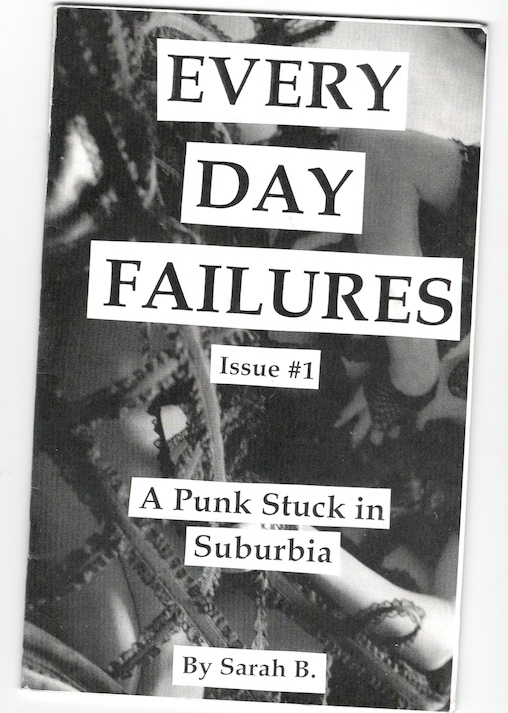
Sarah B. [Punch Drunk Press]
Every Day Failures (meaning failures every day, not commonplace failures) is a perzine that recounts an eight-week period of time in the life of Sarah B.
Shortly after Sarah’s partner leaves her and their two young children for a job in the city, Sarah takes her daughters (ages 3 and 14 months) from the punk house where they’ve been living to her aunt’s much nicer home in the suburbs where she’ll be housesitting for the next two months. During her time of relative isolation in the ‘burbs, Sarah cycles through periods of depression and decadence, shame in her poverty and annoyance by her surroundings.
Like any good autobiographical zine, Every Day Failures provides a snapshot of Sarah’s life and struggles to live according to her own principles. The temporary house-sitting situation eventually ends and Sara presumably returns to the punk house where more every day failures await to become everyday failures. Hopefully, there will be a few every day successes mixed in there as well.
Every Thug is a Lady: Adventures without Gender

Julia Eff [Pioneers Press]
It is timely to be reading this zine about an issue that has been in the news a lot recently. Prior to much of the news coverage on who can pee where, you could have put me in the category of someone who was largely ignorant of transgender issues. The main reason for this is that I didn’t need to know. It didn’t affect me one way or the other so I never bothered to form much of an opinion on it. I accept it. I support it. That was as far as it went. Actually, it’s not something you can really have an opinion on. It’s like having an opinion on global warming. It exists regardless of the thoughts and beliefs of any one person, religious group or political party.
Zinester Julia Eff deals with gender identity issues every day. They’re in her head. Not in her head like she made them up, but in her head as a part of her everyday challenges with life. Julia is dealing with neutrois, a gender identity that is neutral, neither male nor female. Neutrois makes picking out what clothes to wear a challenge for Julia. It determines where she shops and who she chooses to deal with. In one section of the zine Julia talks about her cis gender boyfriend. She describes him as a bit of a Hank Hill-type who doesn’t care about her gender identity. This seems great at first pass, but his acceptance seems to be more about indifference and a lack of curiosity than something resembling acceptance and understanding.
Every Thug is a Lady is an informative zine for those not well-versed in the issues of gender identity. I would hope it was also a cathartic experience for Julia to create. It is entertaining as well in the sense that Julia does have a sense of humor even if the subject matter is dark sometimes. It’s pure perzine, handwritten and lovingly cobbled together. If you are into that you will enjoy it no matter what your gender identification. The zine was originally published in 2011 which makes me feel better about the fact that I took so long to review it.
Firebrands: Portraits from the Americas
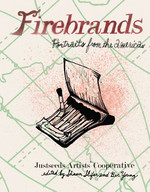
Various [Microcosm Publishing]
Produced by the artists and writers of the Justseeds Artists Cooperative, Firebrands is a compilation of seventy-eight short biographies accompanied by illustrations. Highlighting the lives and struggles of both well-known and lesser-known activists, Firebrands is informative sure, but more than that, it’s inspirational.
The profiles here focus on Americans (North, South, and Central) who have either worked, fought, or died for social change in their communities. From such obvious candidates as W.E.B. Dubois and John Brown to more recent icons like Tupac Shakur (a surprising choice at first glance but completely justified), Firebrands is more in line with Howard Zinn’s People’s History of the United States than with your basic Texas high school textbook. Hopefully, this book will inspire all of us to learn more about these revolutionary individuals now that we’ve been given a glimpse, however brief, into their lives and accomplishments.
A Guide to Picking Locks #2

Crimethinc [Microcosm Publishing]
I would be a bold-faced, dirty, rotten liar if I even pretended that I read this whole zine (or even one-third of it), but believe me, I get the gist. This is a guide to picking locks, like the title accurately suggests. If you want to learn how to bypass all manner of security mechanisms (for good and not evil, of course) then this guide will be incredibly helpful. The reason I personally could not “feel” or “get with” this zine isn’t because I have no practical use for the information—hell, we’ve all been unfairly locked out of something at some point or another—but I don’t possess the mechanical aptitude that’s required to put any of these tutorials into practice. In fact, reading about how things work makes my brain achy. I could watch a TV show about it, however. That’s just my brain though, which shouldn’t take away from the work and research that went into writing this handy guide, so read it… but don’t pick my locks, please.
The Heat and the Hot Earth
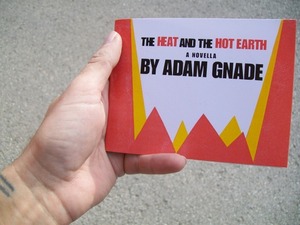
Adam Gnade [Pioneers Press]
Adam Gnade returns with a new novella — a newvella, if you will. The Heat and the Hot Earth continues the story of the aimless youth Gnade established with, Hey, Hey Lonesome. If you’ve read this previous title, you will recognize a few names (Tyler, Ted Boone, Joey Carr) and be introduced to new ones. At least they were new to me, they may have made previous appearances as Gnade often revisits characters in his work. The chapters of The Heat and the Hot Earth are presented in the form of letters, dreams, and blog posts, and from the points of view of the different characters. New or old, it is purported that Gnade will, at some future point in time, unite these characters, situations, and locations and tie them all together into one tight knot. Or not.
Hey Hey Lonesome
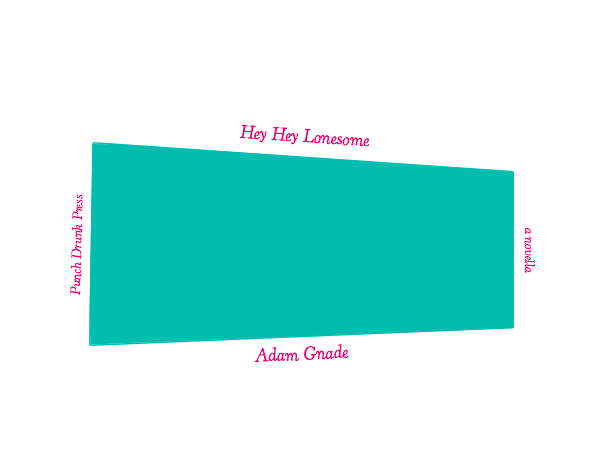
Adam Gnade [Pioneers Press]
This novella, by author and musician Adam Gnade, is intended to introduce readers to the characters that will appear in Adam’s forthcoming novel. It’s a prequel, if you will, that follows the characters around San Diego in the hours leading up to a party where all of their paths will cross. It is at this point that the novel (finished but as yet unpublished) will begin.
Hey Hey Lonesome is a part of a series of fiction and music that loosely ties together various characters through songs and stories. The work is intended to convey a picture of contemporary American life the way American Graffiti portrayed life in the early 60s or more recently Dazed and Confused in the mid-70s. Similarly, the characters in Hey Hey Lonesome are young, shiftless, in or out of love, bored, under the influence, or all of the above. Adam’s prose style even reads like a script at times. The viewpoints of the characters are first person and we hear their inner monologues, but the scenes and action are described like stage directions, sometimes parenthetically. It is unclear at this point how the characters’ lives will intersect and how they will interact with each other, but the scene has been set for the full story to begin. Stay tuned.
How & Why: A Do-It-Yourself Guide
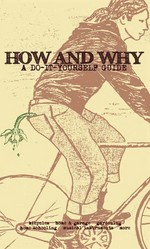
Matte Resist [Microcosm Publishing]
Although I may not attempt all or any of the projects laid out in this book, this is a good resource to have at your disposal. Matte provides step-by-step how-to’s on everything from caring for your own garden to building your own musical instruments.
Internet how-to’s just capitalize on Google algorithms, zeroing in on keywords and bombarding you with more ad links than advice. Like much of the information found on the information superhighway, these web pages can prove to be ultimately frustrating, pointless, and impractical. Don’t get me wrong, I love my Interwebs, but this is a book you can take with you out to the backyard or work shed and get down to the business of building shit.
The main chapters concern bikes, gardening, homeschooling, home and garage and musical instruments. The last chapter is a catchall that gives advice on dumpster diving and tutorials on stencil making, watch repair—a dozen projects in all. That’s the ‘how-to’ part. The ‘why’ is Matte’s own take on why he does the things he does the way he does them.
If you’re at all familiar with Microcosm titles then you should be familiar with the DIY ethos and what that entails, so I won’t break it down here. I’ll just leave you with my own how-to: If you want to get your ass more self-sufficient, then don’t “resist” this book.
How to Make Soap: Without Burning Your Face Off
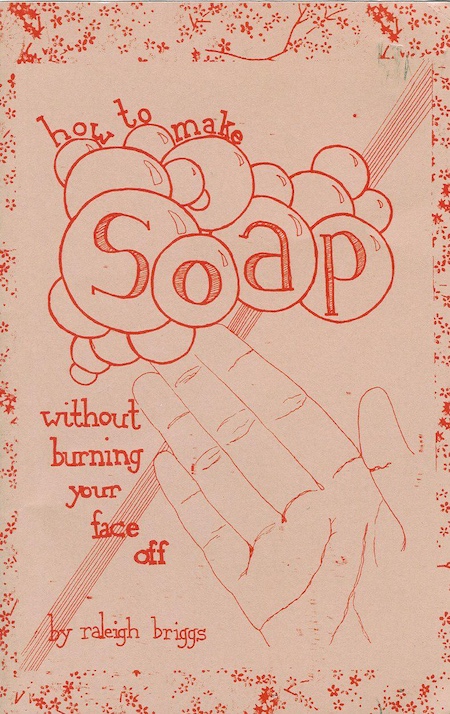
Raleigh Briggs [Microcosm Publishing]
I gotta admit, up until a few days ago, I didn’t know squat about saponification. Hell, I didn’t even know what saponification meant (it means soap makin’). Then I saw this zine on how to make soap and it got me thinking. I thought, wow that’s cool, I could make my own soap. Seems relatively easy too—not like rebuilding the transmission on a 1969 Chevy Nova or nuthin’. Then I thought, what am I nuts? I am never, ever, never gonna make soap. I don’t even use soap! But if I do get the urge to lather up someday and I want to use my own homemade brand of soapy suds, then I have this informative, easy-to-follow, entertaining, and funny guide to help me through the process AND I won’t burn my face off. Bonus! It all reminds me of a story about this guy who didn’t bathe for a whole year.
Read Make Your Place: Affordable, Sustainable Nesting Skills by Raleigh Briggs.
Hurt: Notes on Torture in a Modern Democracy
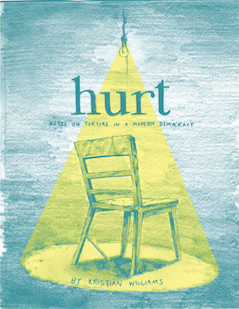
Kristian Williams [Microcosm Publishing]
Hurt is a collection of writings by, and interviews with, Kristian Williams, a Portland-based activist who is the author of two books on state-sponsored violence; Our Enemies in Blue and American Methods: Torture and the Logic of Domination. The essays, interviews, and observations in this book were written and published during, or shortly after, the Bush Administration’s turn at the War on Terror and the subject matter was not something that I was necessarily anxious to revisit.
I Don’t Care I’m Still Free: A Fanzine Celebrating Joss Whedon’s Firefly
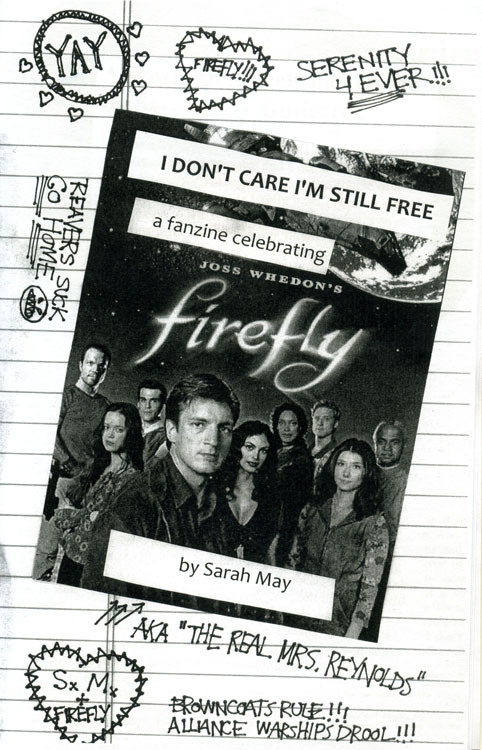
Sarah May [Pioneers Press]
Firefly was a show which aired for exactly one season in 2002-2003. Despite its premature demise, it was quick to attract a cult following which eventually earned the program, and Firefly fans, a full-length movie, Serenity in 2005.
The Firefly saga is set in the future, although it employs cowboy and Western themes in its setting on the outer planets of the galaxy (which have been terraformed to look exactly like southern California).
The zine’s author, Sarah May, is a bit obsessed with Firefly. I’ve watched the series myself and while it certainly has its charms, I find it a bit corny and I sometimes grapple with the sci-fi/Old West hybrid hodgepodge. Some episodes struggle to hold my interest, but I definitely see its appeal. At any rate, this post isn’t about Firefly, necessarily, it’s about a zine about a show called Firefly and it will surely resonate with fellow fans of the show in its unabashed love for this short-lived, rebel cowboys-in-space adventure.
The zine contains trivia, song lyrics, anecdotes and a recipe for Mudder’s Milk, which is an intoxicant consumed by the Mudders while they mine mud in Canton on muddy Higgin’s Moon and worship Jayne Cobb who is one of the crew members on—oh never mind. If you’re a fan you already know all that and as a fan, you should be sure to obtain this handy Firefly companion. Why? Because they can “w” Or something!
Learning Good Consent
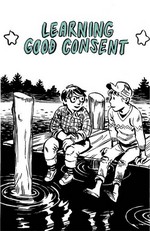
Cindy Crabb [Microcosm Publishing]
This is a reprint of Cindy Crabb’s Doris #15 which serves, it is hoped, as an anti-depression guide. Cindy recommends long walks, daydreaming, remaining active and productive, and drinking lots and lots of coffee. I’m sure scientific evidence would back all these claims up, except perhaps the abuse of caffeine. This zine was originally written in “1999 or 2000” according to Cindy’s best recollection. Certainly then, as now, chemical remedies were a very popular form of curing depression. Certainly, exercise and reconnecting with the outside world can be just as effective, especially for people for whom depression is more environmentally related than a result of chemical imbalances in the brain. But hey, I’m not a doctor, a shrink, a life coach, an Oprah, or even your best friend, so don’t take my word for it. Do consider reading this zine, however, it could only help you shake those blues.
Les CarNets de Rastapoloulos #9
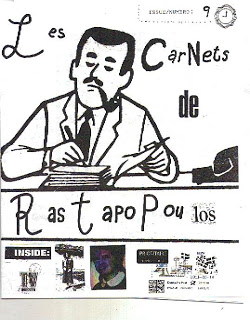
Robert Gauvinov
This is issue #9 of Robert Gauvinov’s Les CarNets de Rastapoloulos zine and the second installment of the pen pal theme. I have not seen the first one, but the backstory is that when Robert was a teenager in Canada in the 1980s, he signed up to become a pen pal through a Communist youth magazine. Quicker than you can say Glasnost and Perestroika, Robert had dozens of pen pals from behind the Iron Curtain. In this issue of the zine, Rob reprints some of these letters with updates from the people who wrote them. This is a pretty fascinating concept and my only complaint is that this zine merely whets my appetite for more. I’d love to find out more about these people who grew up under Communist rule: what were their lives like then? And now? What sort of future did they see for themselves then and what do they see now? More, more, more. I’m greedy. More.
Lumpen #115
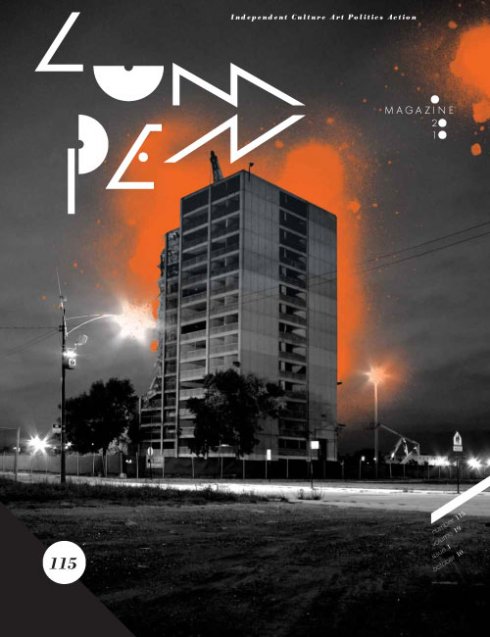
[Lumpen]
Issue number one hundred and fifteen for this staple of Chicago independent publications. Seems like Lumpen is getting back up to the tabloid size of its humble beginnings as the Lumpen Times back in the early 90s. I’m going to go ahead and say that, fluctuations in size and title withstanding, not much has changed with the magazine. What has changed, however, is that the twenty-plus year gentrification of Wicker Park has finally been completed and Edmar and crew have long since left the north side for Bridgeport, “Neighborhood of the Future.” Still free where you can find it and still an impressive effort for this left-leaning quarterly. Articles and commentary in this issue include “Please Don’t Bomb the Suburbs” by William Upski Wimsatt; “Third World America, Here We Come” by Democracy Now!; “Our Water is Not for Sale” by Abigail Singer plus comics and reviews.
Manifesto #1
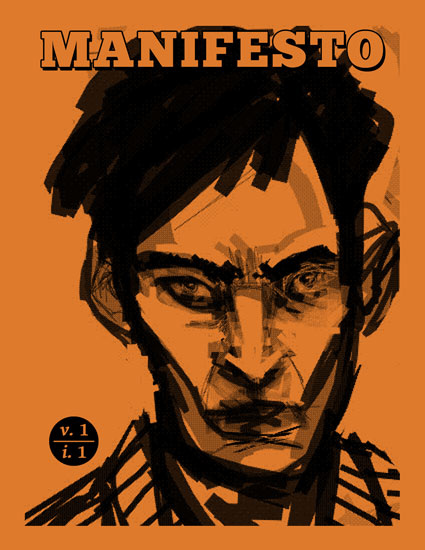
Ed Tillman
This small (four-by-five-and-a-half inch) zine concerns itself with art. That is to say, fine art. Manifesto’s introduction to the world starts with an accounting of a conversation among friends about what constitutes art. After the futility of that question is established, the rest of the zine features short snippets by various artists on a variety of art-related subjects.
“Polaroid” waxes nostalgic for the archaic camera and film. “Dirty Filthy Art” recommends good old preservative-filled white bread to clean up old paintings and “Plate Glass Observations” is people watching in an LA neighborhood through the window of a tiny Greek restaurant. If you’re artistically inclined or merely artistically interested in art, this zine was made with you in mind.
Maps to the Other Side
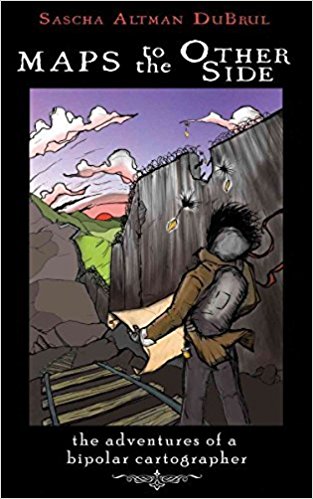
Sascha Altman DuBrul [Microcosm Publishing]
Sascha Altman DuBrul is a writer, wanderer, punk, farmer, squatter, musician, activist, and the founder of The Icarus Project — the radical mental health network that seeks to redefine the public’s perception of mental illness. Sascha is himself bipolar. Instead of viewing his condition as an affliction or disease, Altman views it as a “dangerous gift,” something that can be used as a tool to create.
Maps to the Other Side is a collection of Sascha’s writings over the years. Whether this was evident to him at the time or not, Sascha now recognizes these stories as guideposts in a lifelong journey. Some of these writings appeared in zines, like Slug and Lettuce and The Secret Lives of White People, some are from the column “Bipolar World” that he wrote for the San Francisco Bay Guardian, and some are simply pieces Sascha wrote for himself.
The book is subtitled “The Adventures of a Bipolar Cartographer.” In his understanding of how is own brain works, Sascha sees his mind as a map that requires navigation and time to figure out. This makes Sascha a mental mapmaker. Like most people living with bipolarism, Sascha veers off course from time to time. This is alarming and alienating to those around him when it happens and this book seeks to help people understand the unpredictable nature of mental disorders. Part memoir, part travel diary, part “how-to,” Maps to the Other Side should be all parts inspirational to those charting the same course, informative to those who are not, and enlightening to all.
Meal Deal with the Devil
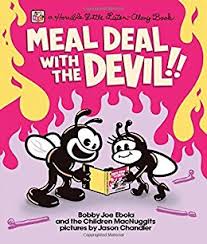
Bobby Joe Ebola & The Children MacNuggits Pictures by Jason Chandler
[Microcosm Publishing] [Horrible Comics]
Meal Deal with the Devil is a children’s sing-along book that is in no way intended for children— my favorite kind! Modeled on the “Little Golden Books” we all grew up with as little nuggits, the book is a product of Dan Abbott and Corbett Redford, the musical comedy duo known as Bobby Joe Ebola & The Children MacNuggits. These two satirizing punks have been skewering icons and slaughtering sacred cows for a decade and a half.
Meal Deal comes with a CD that features five tunes. “Naked Beach Party (On the White House Lawn)” is a surf rock rave-up D.C. style. “Broken Bottles,” is an accordion jam that seems to be about cooking broken glass. “Punk, You Let Me Down,” is an old-school rap-style admonishment of present-day punks who just can’t let go of a dated fashion trend. The book itself is to be read while listening to tracks four and five on the CD. “Down at the Jamboree” advocates partying with furry and four-legged friends and “The Town with No Beer,” is a harrowing story about a town that has run out of hops. The book is illustrated by Jason Chandler in comical fashion. Meal Deal is suitable for adult children of all ages.
Nesting: Self-Care Tips for Autumn and Winter
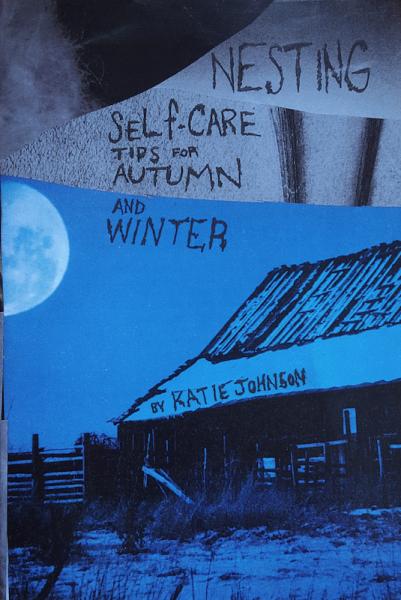
Katie Johnson [Pioneers Press]
This short zine provides tips for taking care of yourself as the temperature drops lower and lower and the sun drops sooner and sooner. It includes advice on a whole manner of things, such as eating the right foods, sleeping the right amount of time, waking up correctly, and going to work like a boss. There are tips for managing the whole day in fact, including the proper way to hit the sack.
Winter is a tough one for everybody, but some people are affected to a stronger degree than others. Doing the things outlined in this zine will cost you nothing and may even save you a buck or two as Katie advocates abstaining from alcohol during these months. A good many lot of us rely on booze to get us through these frigid times, so observing this particular bit of advice ain’t gonna be easy. In fact, I ain’t even gonna try. Other things like eating right, reading before bed, stretching, and staying hydrated are easy enough. It’s good to have all these tips compiled here in one place where they can be referred back to as needed. So get it, read it, and good luck, everybody!
The New Death & Others
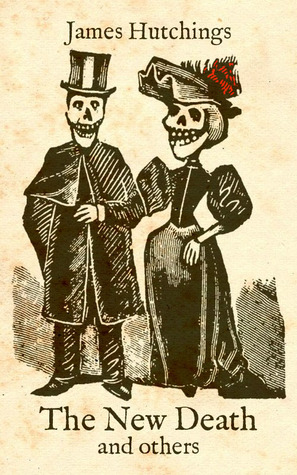
James Hutchings [ebook on Smashwords]
The New Death & Others is an e-book that collects forty-four stories and nineteen poems by James Hutchings. It’s what Hutchings himself describes as “dark fantasy” but containing “no sparkly vampires.” While there are a few vampires mentioned in the book, perhaps they do not qualify as “sparkly”. What New Death does contain is dozens of short (some very short) satirical tales, fairy tale parodies, creation stories, humorous legends, and fantastic fables. There are also poems about cats, the moon, and various Gods. Interesting, if not completely captivating and entertaining, if not enthrallingly so, The New Death seems like it was probably a lot of fun to create and possesses a certain charming sense of humor. I can’t help but to wonder, however, if perhaps this collection wouldn’t be better served as an illustrated book in printed form that could occupy a permanent space on a shelf or a table and be periodically returned to for a quick fix of fantasy, maybe with a cup of tea on a dark and gloomy day. One gets to wondering when one reads this sort of thing at any rate.
No Apocalypse
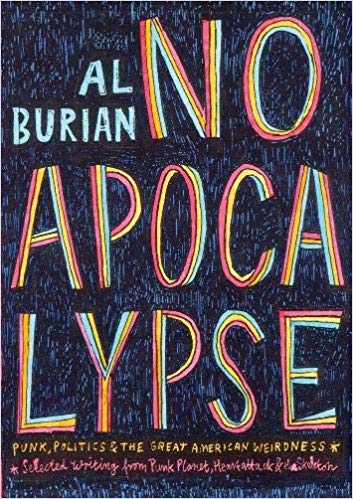
Punk, Politics, and the Great American Weirdness
You may know Al Burian as the guitarist for the Chicago, by way of Chapel Hill, post-hardcore band Milemarker, or that band’s offshoot, Challenger. Perhaps you know Al through his long-running perzine Burn Collector, or from his columns in zines Punk Planet and HeartattaCk. Maybe you’d recognize him from his long stint behind the counter of Quimby’s bookstore in Chicago. Or maybe you wouldn’t know him from any of these places.
Al lived in Chicago for the better part of aughts. Even though he made zines in this town and his bands played the local punk rock circuit, I don’t believe our paths ever crossed. Or maybe I wouldn’t have known it if they had. That’s actually the more likely scenario. Chicago is a big sprawled out mess sometimes and even in smaller underground circles, there’s a lot of separating space. At any rate, I did read Burn Collector and Punk Planet. I was also socially and politically aware during those years of regime change, hanging chads, and punk rock purity, which is why No Apocalypse sparked recognition and triggered a few twinges of nostalgia (thankfully, just a few).
The book is a collection of writings originally published between 2000 and 2007 in Punk Planet, Heartattack, and the short-lived Skeleton. The apocalyptic theme suggested by the title doesn’t really tie these pieces together, and the subtitle Punk, Politics, and the Great American Weirdness hints at Gonzo journalism more than it delivers. In these columns, Al ruminates on American cuisine, war, Y2K, gentrification, and dental dilemmas, but more generally, this collection illustrates the thinking of an itinerant creative type in the underground at the dawn of the 21st century. Nevertheless, No Apocalypse is a good read and a collection of stuff you can’t find anywhere else.
Al left Chicago in 2007 and eventually left the U.S. altogether. He has lived in Germany for the past decade where he continues to write and make comics. Al will be the main attraction at a free event at Quimby’s Bookstore tomorrow night where he will read selections from No Apocalypse. Al’s serial graphic novel Dean Street, made with German comic artist Oska Wald, will also be making its U.S. debut.
The People’s Apocalypse
Edited by Ariel Gore & Jenny Forrester [Lit Star Press]
OK, so the world didn’t end again this time either, but it’s for sure gonna end next Tuesday, so plan on that. The People’s Apocalypse, edited by hip mamma, Ariel Gore and writer Jenny Forrester, compiles writings related to the End Times, Doomsday, The Apocalypse, or Next Tuesday, as I call it.
I don’t know if we are more obsessed with the end of the world now than we were ten, twenty, or a hundred years ago, but we certainly have many more outlets through which to feed our morbid fantasies. Doomsday Preppers, Zombies, Global Warming, Honey Boo Boo, there’s an apocalyptic feeling in the American psyche for sure, so a book like The People’s Apocalypse fits right into this cultural phenomenon.
The anthology contains short stories and essays which seek to explain, or at least give advice on, everything from how to prepare for the impending Zombie Apocalypse to how to raise chickens. In both fictional and nonfictional forms, writers and zinesters Tomas Moniz, Yasmin Elbaradie, Evelyn Sharenov, Derrick Jensen, Roy Coughlin, Margaret Elysia Garcia, Vickie Fernandez, Dani Burlison, and many more, give their own expressions, thoughts, and feelings on what can be a serious or seriously silly topic. Of course, the end of the world is millions of years away, but the end of humans? That’s another story and shouldn’t really be the cause for too much grief or hair-pulling. Who’d miss us anyway?
Proof I Exist #11
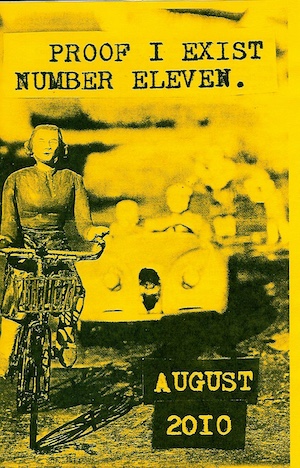
Billy Da Bunny
I bought this zine at Chicago Comics. It’s rare that I get to that part of town anymore and my budget for zines and comics (and music and cool stuff in general) has been seriously curtailed in recent times. In fact, I felt like a real shlub browsing for thirty minutes and only spending ten bucks, but that’s the reality of “these economic times.” At one buck though this zine was priced right. It wasn’t until I was riding the train home and had gotten halfway through Proof I Exist that I realized that I had heard of this perzine before and that I actually know the publisher, Billy, from his days running Loop Distro. I think my band even played a house show at his crib (The Control Room) back in the dizzily day. You are to please excuse the digression, but it actually keeps in check with the theme of PEI #11: it’s about looking back.
Read Proof I Exist #46 and other zines from Billy McCall.
Read an interview with Billy McCall.
Rad Dad #18

Tomás Moniz [Microcosm Publishing]
This issue is my first introduction to Tomás Moniz’s Rad Dadzine. Rad Dad represents the perspective of parents who are also anarchists trying to find a balance between those two things. RD#18 is the ‘Sex & Love’ issue and features short bits from various like-minded contributors who share their parenting stories. Tomas tells of his own efforts in talking to his kids about sex when he discovers that his son had downloaded hardcore pornography to his (Tomas’) computer. Dani Burlison shares her aborted plan to bribe her daughter to not kiss a boy until she is eighteen. There are several contributors who share their experiences with open and polyamorous relationships as well as an interview with Chris White, Director of Education at the National Institute of Human Sexuality (SF State University). I’ve never read a parenting guide quite like this, in fact, I’ve never read a parenting guide (I’m not a parent), but this one definitely speaks to a very specific audience about a very universal topic.
Rad Dad #19

Tomás Moniz, Ed. [Microcosm Publishing]
Editor and rad dad, Tomas Moniz is back with another issue of his Rad Dad zine. The purpose of Rad Dad is to help guide dads in the raising of their kids. Actually, it’s not a guide necessarily, although it does serve that purpose. Tomas’s goal is to share stories, thoughts, and observations on parenting with like-minded parents who have made their share of mistakes and have learned from them. The contributors are not all dads either, but they are all activists, organizers, musicians, and artists. They’re definitely to the left politically and the challenges they confront while parenting range from issues like early gender identity (“The Handsome Daughter” by Laura Pretnar) to food activism (“How to Turn Your Kids into Radicals” by John Chapman). There are interviews with activist/writer John Conant and Pittsburgh musician JonJon Cassagnol, as well as several pieces remembering Oscar Grant who was fatally shot by BART cops in Oakland in 2009.
Rad Dad: Dispatches from the Frontiers of Fatherhood
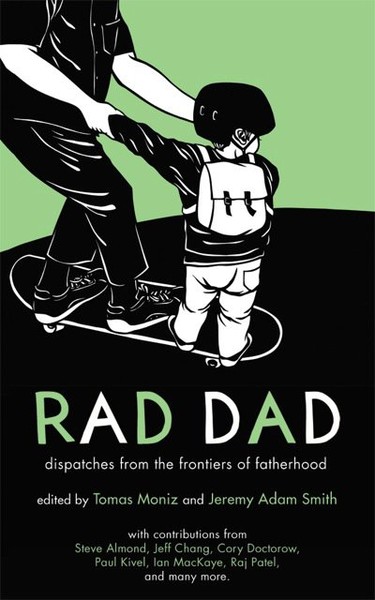
Edited by Tomás Moniz & Jeremy Adam Smith [Microcosm Publishing]
The Rad Dad book is a greatest hits package of the zine Tomas Moniz has been publishing for going on twenty issues now. It’s written for men who may be struggling with all the complexities of being a father in this or any age. The book is broken up into sections: “Birth, Babies, and Toddlers,” “Childhood,” “Tweens and Teens,” and “Politics of Parenting.” The last section of the book features interviews with rad dads like hip-hop writer Jeff Chang (Can’t Stop Won’t Stop) and Ian MacKaye (Minor Threat, Fugazi, The Evens, Dischord Records). I am most certainly rad but not a dad, so I haven’t read every article and essay in this book, but some are interesting regardless of your parental status (“Notes From a Sperm Donor” for example). If, however, you have achieved fatherhood and are looking for advice, find comfort in the fact that you can turn to the pages of Rad Dad, now in handy book form.
The Recoup #1
Joseph Kyle, Publisher [self-published]
The debut issue of this slender digest-sized zine is dedicated to the past: music and musicians that have been forgotten or overlooked. Music has no expiration date as publisher, Joseph Kyle, points out in his intro, so why not go back and revisit what has gone before? There’s nothing new under the sun anyway and, let’s face it, if the world stopped producing new music today, would anybody even notice? Probably, but anyway…
SCAM: The First Four Issues
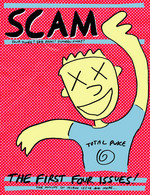
Erick Lyle [Microcosm Publishing]
Even though this four-issue anthology of Erick Lyle’s Scam zine almost hits the 300-page mark, it’s still an abridged version! That’s pretty impressive. What makes Scam different from hundreds of other punk rock zines is that its focus was not just on music and it wasn’t overtly political either, yet it was entirely political because it served as a guide to living outside society.
Scam unabashedly encouraged theft, vagrancy, squatting, and vandalism (as well as beer consumption). Scam was to be taken literally and was a part of the punk rock ethos of its creators. Taking what you want and doing what you want to do was central to this. From generator shows and squatting to scamming free copies at Kinkos and dumpster diving, Scam was equal parts how-to and holy-shit-look-what-I-got-away-with-you-can-too.
Scam was a cut-and-paste, handwritten, collage-style publication so unfortunately, much of it is difficult to read. I’m sure the thought of transcribing the handwritten text into a more readable type would be considered heresy in the Scam Camp, but it did make for rough going and I couldn’t make it through the bulk of it. Maybe that’s not a bad thing.
Not every article still has relevance or will resonate with every reader. That’s true with most zines. I was able to read enough to get a general understanding, however. Enough to recognize Scam’s role as an important document of punk rock life in the 90s—a decade that, despite current public sentiment, was full of activism and great music, but is more associated with Grunge, Green Day, and lo-fi, than punk rock. That’s a common perception that maybe this zine will help change. So keep scammin’ kids… but don’t scam me, please.
Shut Up & Love the Rain
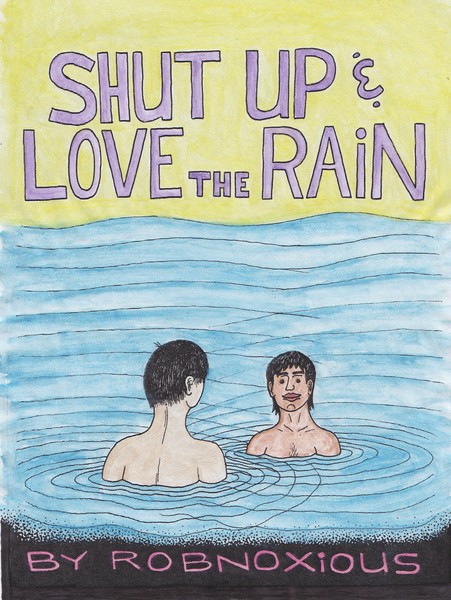
Robnoxious [Microcosm Publishing]
Zinester, comic artist, blogger, and sex-positive queer activist, Robnoxious produced this zine/comic hybrid that deals with his path towards discovering his sexuality. From childhood experimental encounters through his first homo- and heterosexual experiences, Rob presents a pretty straightforward, honest assessment of his evolution into what he calls a “uber-healthy queerness”. Rob also gives his own definition of what “queer” means to him, which is basically whatever he wants it to mean.
Shut Up & Love the Rain also features an interview Rob conducted with his parents about his father’s coming out as transgendered. Heavy, right? You would think, but many times in these situations there is more collective relief than anger or confusion and that seems to be the case with Rob and his family. Just goes to show that a little honesty and communication can go a fuck of a long way in resolving any difficult situation.
Simple History #10: The Cold War
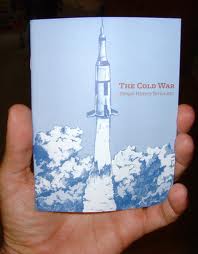
J. Gerlach [Microcosm Publishing]
J. Gerlach is back with another mini-history lesson, this time on the Cold War between the two Super Powers of the mid-to-late 20th Century: USA vs. USSR. The Cold War is quickly becoming a distant memory as we fry new fish in the 21st century. We like our wars a bit warmer now, but the War on Terror still plays the same games. We still prop up weaker allies whose interests we believe match our own while inadvertently sowing the seeds for future conflicts. This is now and that was then, however.
In this current installment, Gerlach lays out all the major events and the players in his Cliff’s Notes of History style. You got your revolutions, your arms races, your pacts, your treaties and agreements as well as espionage, airlifts, thaws, freezes, police actions, standoffs, and stalemates and it all ended when Mr. Reagan asked Mr. Gorbachev to tear down that wall in Berlin. Not quite, but I’ve heard it spun that way. Let us also not forget that the Cold War produced some great movies too. No, I’m not talking about Dr. Strangelove and the Manchurian Candidate, I’m talking about Red Dawn and Spies Like Us!
Simple History #9: The Congo

J. Gerlach [Microcosm Publishing]
To quote the Daily Show’s Earth, The Book: “…no other continent could more truly say, I was raped.” Talking of course about the continent of Africa. Pretty blunt, but there you have it. The area in central Africa known as the Congo is just one region, albeit a very large one, that was ripe for exploitation by European powers in the mad rush to secure the world’s land and resources that started in the 16th Century. In the Congo’s case, it was Belgium that took the lead, but they seemed to hardly have the heart for it.
Control of the Congo was ceded and regained countless times as slave trading, foreign meddling, and the indigenous peoples’ inability to work out their own tribal differences and prejudices would plague them for decades to come. Congo’s recent history is no less blood-free and has been mired in civil war and struggles with power-hungry dictators and staggering poverty. And that’s a summation of J. Gerlach’s simple history of a very complicated region of a very complicated continent. If I may again quote from Earth, “Our species arose from Africa and we punished it for our failures ever since.” Up next: Extreme climate change. Sorry again, Africa.
Simple History #5: Hawaii
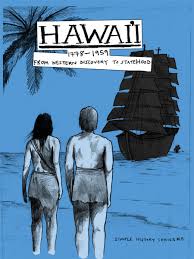
J. Gerlach [Microcosm Publishing]
Number five in Microcosm’s Simple History Series chronicles the history of the Hawaiian Islands from their “discovery” by Captain Cook in 1778 to the eventual statehood granted by the United States in 1959. Hawaii’s story is a tale of colonization, exploitation, imposed capitalism and governments and corporations slicing themselves up the biggest piece of the poi. It’s a story of Kings, Queens, Politicians, Missionaries and, as always, ordinary People caught in the middle. And that, folks, is pretty much the history of everything everywhere. Unfortunately..
Hawaii’s history post-1959 would continue to have highs (the alleged birth of the 44th President of the United States) and lows (Honolulu’s perpetual hosting of the National Football League’s incredibly pointless Pro Bowl) and then, of course, there was Bobby Brady’s “discovery” of an ancient tiki on September 22, 1972.
Simple History #4: The Spanish Civil War

J. Gerlach [Microcosm Publishing]
Microcosm’s Simple History Series is a collection of small zines on big historical events. They’re sort of like the notes that a really good student would take in a history class while the rest of us doodled and decorated the covers of our notebooks with our favorite bands’ names (Me: Hüsker Dü, You: Mötely Crüe, probably). The subject of issue number four is the Spanish Civil War—another major turning point in the war between left and right-wing ideologies that would preoccupy world powers for the next few wars (hot and cold) for the bulk of the 20th Century. This edition is interesting, easy to digest, and kind of a cool thing to have on the bookshelf next to your Johnny Ryan comics—kinda classes things up a bit (no offense, Johnny).
Think Tank DIY #1 & #2
Reggie Martinez [Punch Drunk Press]
Brevity is the soul of wit, said some guy one time, and Shakespeare was right. Brevity also makes for easy-to-read zines like Reggie Martinez’s Think Tank DIY. In these few pages of issues one and two, Reggie offers up his ideas for a number of movies, cookbooks, novels, and restaurant projects. He offers them all for free and wishes anyone well should they try to turn one of them into a profitable business venture. Reggie asks for nothing in return, not even credit for the idea. That said, many of these ideas would be impossible to pull off, or at the very least, not worth the time and money necessary in the attempt. A 24/7 doughnut delivery shop called Dough Not Leave the House (plausible) an Angry Birds parody titled Angry Nerds (I can see it) a parody artist called Natalie Merchant of Venice, who sings lines from Shakespeare (see above) to the tune of 10,000 Maniacs songs (pretty narrow demographic, but sure), these all could be accomplished, but at what cost in human suffering? Anyway, you get the idea about Reggie’s ideas. The best idea he’s had so far may be this zine about his cockamamie ideas.
Travel On #4 & #5
David Solomon
Travel on #4, according to its author, David Solomon, is a “perzine consisting of fictional stories, personal letters, nonfiction ramblings and a personal list of accomplishments loosely related to David’s temporary job killing plants for the National Park Service.” I love it when someone does all the work for me. I could end this review right now because, between that description and the zine’s subtitle (“Six Months in South Carolina”), my work is done. However, let me add that it’s in digest format with a double saddle stitch. In addition to those particulars, I learned from reading this zine that David is very passionate about his beard, he loves working out of doors (when it’s not raining too obnoxiously), he enjoys writing letters and short stories (some very short) that may or may not contain a plot or any point whatsoever. Buy Travel On #4 at David’s Esty Store why doncha’.
Travel On #5: Letters, remember them? Of course, you don’t. We don’t write them anymore, but we used to. We used to put these lickable little squares called “stamps” on ‘em and then this thing called the Post Office would deliver them for you. To wherever you wanted. You used to love getting them and hate writing them if they were to thank someone for a gift. You had to sit down and summarize your life. You had to think about it longer than the time it takes to fart out a tweet or a status update. If you liked something you might have to commit a whole paragraph to it instead of clicking on a little icon of a thumb pointing upward.
Well, this lost art isn’t lost on David Solomon as he seems to have a number of pen pals with whom he corresponds. His letters make up much of the fifth issue of Travel On along with a few vignettes and literary tidbits. David works for the National Park Service in a job that has him traveling to various woodsy, secluded, and mountainous areas of the country that few civilians will ever see. It sounds idyllic yet pretty difficult as well, but it also seems to allow for plenty of time for self-reflection and the creation of zines like this one. Buy Travel On #5 at David’s Esty Store!
Trans-Siberian
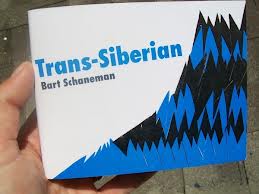
Bart Schaneman Pioneers Press]
Trans-Siberian is a travelogue in mini-zine form making it the perfect size for globe-trotting. It’s literally a pocketbook of stories and observations about Bart’s travels from Korea to Russia via China and Mongolia.
The story begins with Bart having just finished a job in Korea. He flies to Shanghai, moves on to Mongolia, and finally reaches his destination in St. Petersburg, Russia, home of his great-grandfather, a Russian of German origin. In and along this route, and in no particular order, Bart interacts with fellow travelers on trains and in bars and hostels. He eats local cuisine. He is warned to be wary of the Mongols. He goes on an intercity car race with Russian teenagers. He drinks the local booze, takes in the scenery, and is oftentimes alone, under the stars with his thoughts.
The story begins with Bart having just finished a job in Korea. He flies to Shanghai, moves on to Mongolia, and finally reaches his destination in St. Petersburg, Russia, home of his great-grandfather, a Russian of German origin. In and along this route, and in no particular order, Bart interacts with fellow travelers on trains and in bars and hostels. He eats local cuisine. He is warned to be wary of the Mongols. He goes on an intercity car race with Russian teenagers. He drinks the local booze, takes in the scenery, and is oftentimes alone, under the stars with his thoughts.
Bart’s writing is well-paced and moves quickly with him as he glides through the cities and countryside of Asia. His journalistic chops are intact even as he keeps his writing on a very personal level which makes it interesting reading without being melodramatic.
Unemployment
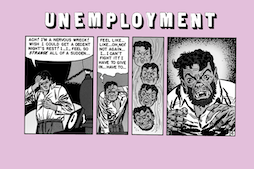
Aaron Lake Smith [Microcosm Publishing]
Zine writer Aaron Lake-Smith (Big Hands) finds himself unemployed in this one-off issue of Unemployment. Over the course of seven chapters, Aaron contemplates the paradox of his situation (What’s better? Free, but no money; money, but no free time) as well as the age-old question of how to survive as an artist in a society that makes that pursuit extremely difficult. Aaron also wishes he could enjoy just one day of unemployment without the nagging dread of what the future may hold. He almost takes a job as a data entry temp but holds out unsuccessfully for more money, unwilling to rationalize working for less than he believes he’s worth. Unfortunately, in this economy, we’re worth what someone is willing to pay us and nothing more.
Unsinkable: How to Build Plywood Pontoons & Longtail Boat Motors Out of Scrap

Robnoxious [Microcosm Publishing]
Part Huckleberry Lewis and part Meriwether Finn, Unsinkable is a tale of life on the river—that river being the Mighty Mississippi and that life being a few months spent aboard the shanty boat Snowball. Now I knew punks lived on the streets and I knew punks lived out in the sticks. I knew punks hopped trains and crisscrossed the country like the hobos of yore, but it never, ever occurred to me that there were punks on America’s waterways. But there are and leave it to Robnoxious to provide me with an education on the subject.
The subtitle of the zine is “How to Build Plywood Pontoons & Longtail Boat Motors Out of Scrap” and Unsinkable is a bit of a how-to mixed with a travel diary (I’d say it’s about 90% travel to 10% how-to). I’m not a very technical person, I don’t build things out of other things, so I was more interested in the human side of the story.
The Flight of the Snowball, the journey itself starts in Kansas City, Missouri and follows Robnoxious and friends, both human and canine, on a river voyage that ends in Caruthersville, MO. Floods, strong currents, and things that float off in the night were just a few of the hardships the crew of the Snowball had to contend with. Drinking, smoking, camping, chilling, and letting the river set the pace provided the balance. It sounds like a soggy, muddy, and sometimes dangerous good time.
Also included is a humorous article on the Asian Carp by Savannah who got caught in a fish mosh by this invasive species. The Asian Carp fearlessly fling themselves at the heads of unwary water travelers and as a result, can do some serious damage to your cranium. Come on, Asian Carp! That kind of rude behavior is gonna get your ass on a Long John Silver’s menu, but probably under a different name and very heavily battered.
Xerography Debt #25

Davida Gypsy Breier, Editor [Leeking Ink]
It warms one’s heart cockles to see a zine like Xerography Debt still being published. It warms the ventricles of one’s heart to see any zine being published period, especially one that supports other zines like XD does. Yes, this is a review zine with “perzine tendencies” that still firmly supports independent publishing and the underground press. Many zine publishers have ceased publishing in recent years, some of those finding refuge in electronic media (like the Reglar Wiglar) while others give up the ghost of print completely. Not so with Davida Gypsy Breier. In fact, this issue looks better than ever with a great cover and clean, well-designed, easy-to-read copy. So, viva la zine!
Xerography Debt #26
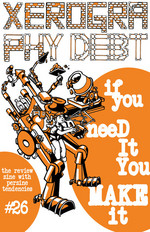
Davida Gypsy Breier, Ed. [Leeking Ink]
As Davida explains in the “Basic Stuff You Should Know” section, XD is a hybrid of a review zine and a personal zine. As such, this issue like its predecessors, features columns concerning the writers’ personal relationships to zines and self-publishing, and then of course there are the reviews. This issue features reviews by Clint Johns who was the zine buyer at Tower Records. It was Clint, in fact, who agreed to carry the Reglar Wiglar zine back in the early aughts, which I will always be grateful for. Microcosm founder Joel Biel also contributes a column and some reviews as well. Still a great resource to find out who’s doing what from publishing vets to upstarts.
Xerography Debt #28

Davida Gypsy Breier, Editor [Leeking Ink]
Xerography Debt isn’t your father’s Factsheet Five (it’s much smaller) and it’s not your mother’s Zine World (the reviews are too positive), but Davida and her small band of volunteers have been carrying the torch for zinesters and the small press for almost thirty issues now.
Xerography Debt #29
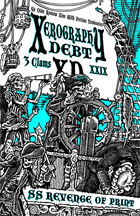
Davida Gypsy Breier, Editor [Leeking Ink]
Xerography Debt isn’t your father’s Factsheet Five (it’s much smaller) and it’s not your mother’s Zine World (the reviews are too positive), but Davida and her small band of volunteers have been carrying the torch for zinesters and the small press for almost thirty issues now.
Number 28 keeps with the familiar XD format of columns and reviews. Columnist Dread Sockett defends XD’s decision to run only positive reviews; Inner Swine, Jeff Somers provides an explanation of why he keeps his opinion of other zines out of his own; Gianni Simone highlights the dying but not-quite-dead art of mail art and a handful of faithful zine readers tell us about the cream of the small press crop. Also in this issue is the second installment of the “Where Are They Now” feature which asks former zine publishers a few questions about why they stopped publishing and if they plan to ever take up the small press pursuit again. Some will, some won’t and issues of time and money are invariably the reasons for stoppage.
Zinester’s Guide to NYC
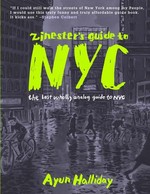
Ayun Halliday [Microcosm Publishing]
The Zinester’s Guide to New York City is the second installment of such handy guides published by Microcosm (the first being the Portland version). For this two-hundred and fifty-plus page book, writer and zine publisher Ayun Halliday (East Village Inky) gathered contributions from dozens of writers and artists who offer up their choices of favorite restaurants, bars, live music venues, parks, and special events in NYC. Very useful and well-thought-out with a handy index section in the back of the book, although the section on public restrooms could be expanded, perhaps with a map and a star rating system…. anyway, just a suggestion. Illustrated and informative whether you are a New Yorker or just passing through. Includes artwork and writing from Liz Baillie, Carrie McNinch, Heath Row, and many, many others.
Zinester’s Guide to Portland
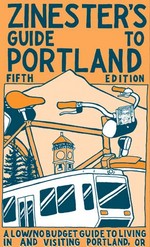
[Microcosm Publishing]
Never been to Portland—not Portland, Oregon, not Portland, Maine. I have watched five episodes of Portlandia, however. Does that count? Didn’t think so. If I ever do make it to the City of Roses (Portland, OR), I will surely be taking this guide with me.
The Zinester’s Guide to Portland was put together by zinesters, but you certainly don’t need to be a zinester to use it. It’s written for the “low/no budget” type of traveler, which is a category I fall into. Museums, thrift stores, record and book shops, restaurants, bakeries, video stores, pizza joints, watering holes, coffee and tea shops, parks, and bridges are all listed, laid out by geographic location and neighborhood, and explained. It’s a Portlandicopia of useful information complete with maps and illustrations. It really makes me want to jump on the next Empire Builder out of Chicago for a slice of Portland’s Sizzle Pie pizza.
